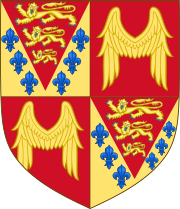
Back Vévoda ze Somersetu Czech Duke of Somerset German Ducado de Somerset Spanish Duc de Somerset French דוכס סאמרסט HE Duca di Somerset Italian サマセット公 Japanese Hertog van Somerset Dutch Książę Somersetu Polish Duque de Somerset Portuguese
| Dukedom of Somerset | |
|---|---|
  Arms of Seymour: Quarterly: 1st and 4th, Or on a Pile Gules between six Fleurs-de-Lis Azure three Lions of England (being the Augmentation of Honour granted by King Henry VIII on his marriage with Jane Seymour); 2nd and 3rd, Gules two Wings joined in lure the tips downwards Or (Seymour) | |
| Creation date | 1443 (first creation) 1448 (second creation) 1499 (third creation) 1547 (fourth creation) 1660 (fourth creation, restored) |
| Created by | Henry VI (first creation) Henry VI (second creation) Henry VII (third creation) Edward VI (fourth creation) Charles II (fourth creation, restored) |
| Peerage | Peerage of England |
| First holder | John Beaufort, 3rd Earl of Somerset |
| Present holder | John Seymour, 19th Duke of Somerset |
| Heir apparent | Sebastian Seymour, Baron Seymour |
| Remainder to | the 1st Duke's heirs male of the body lawfully begotten |
| Subsidiary titles | Baron Seymour |
| Extinction date | 1444 (first creation) 1464 (second creation) 1471 (second creation, titular) 1500 (third creation forfeit) |
| Seat(s) | Bradley House Berry Pomeroy Castle |
| Former seat(s) | Bulstrode Park |
| Motto | Foy pour devoir (Faith for duty)[1] |
Duke of Somerset, from the county of Somerset, is a title that has been created five times in the peerage of England. It is particularly associated with two families: the Beauforts, who held the title from the creation of 1448, and the Seymours, from the creation of 1547, in whose name the title is still held. The present dukedom is unique, in that the first holder of the title created it for himself in his capacity of Lord Protector of the Kingdom of England, using a power granted in the will of his nephew King Edward VI.
The only subsidiary title of the duke of Somerset is Baron Seymour, which is used as a courtesy title by the eldest son and heir of the duke. This courtesy title is the lowest in rank of all heirs to dukedoms in the peerages of the British Isles, yet the holder's precedence is higher than his title suggests, by virtue of the seniority of the Dukedom of Somerset (the only more senior non-royal duke is the Duke of Norfolk).
Several other titles have been held by the dukes of Somerset, but have become extinct. These include: Earl of Kendal (created 1443, extinct 1444), Earl of Somerset (created 1397, forfeit 1461), Marquess of Dorset (created 1397, degraded 1399; created 1442, forfeit 1461), Marquess of Somerset (created 1397, degraded 1399), Earl of Dorset (created 1441, forfeit 1461), Viscount Rochester (created 1611, extinct 1645), Viscount Beauchamp of Hache (created 1536, forfeit 1552), Earl of Hertford (created 1537, forfeit 1552; and created 1559, extinct 1750), Marquess of Hertford (created 1640, extinct 1675), Baron Seymour of Trowbridge (created 1641, extinct 1750), Baron Percy (created 1722, separated 1750), Baron Cockermouth (created 1749, separated 1750), Earl of Egremont (created 1749, separated 1750), and Earl St. Maur (created 1863, extinct 1885).
The ducal seat is Bradley House in Maiden Bradley, west Wiltshire, with a secondary estate at Berry Pomeroy Castle, Totnes, Devon. The principal burial place for the Seymour family today is All Saints' Church, Maiden Bradley, adjacent to Bradley House; the church and the family cemetery can be reached from the grounds of Bradley House via private access.[2]
- ^ Debrett's Peerage, 1876, p.437
- ^ The grave of Algernon Seymour, 15th Duke of Somerset, 19 July 2013